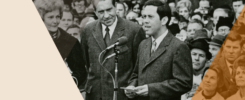Transcript for Episode 6 of the 2023 Season of Talking Hoosier History
Written and produced by Jill Weiss Simins.
A young farmer rose early and headed to the fields to pick tomatoes. It would be arduous and backbreaking, but still better than working inside at the nearby cannery, peeling tomatoes, adding them to jars, and running label machines. The large boilers made the work hot and uncomfortable – so, better to be out in the fresh air. He was far from home and missing his family, and his accommodations weren’t exactly luxurious, but he would be proud to return home with extra money. He could also be proud of the work itself, because these weren’t just any tomatoes he was picking. He was helping with the agricultural production needed to feed the U.S. military, Americans on the home front, and Allies abroad during WWII. Despite his patriotic contribution, including the long hours he would spend in the sun, some Hoosiers were not welcoming because he was from Mexico. Yet he, and the hundreds of other Mexican workers who arrived in Indiana in early 1944, came at the behest of the U.S. government. They were the braceros. And they would help win the war.
I’m Justin Clark and this is a short episode of Talking Hoosier History.
The United States and Mexican governments created the Bracero Program in 1942 and by early 1944 braceros were laying railroad tracks and picking and canning produce in the Hoosier state. Indiana newspapers reported widely on the shortage of workers caused by the war and most supported the importation of workers. When the workers actually arrived in their hometown, however, Hoosier responses varied, from attempts to run them out of neighborhoods and accusing them of local crimes to wholehearted welcome and support.
In Irvington on the east side of Indianapolis, a small but vocal group of citizens made it clear that they did not want Mexican laborers living in their neighborhood. The Indianapolis News reported that “Historic Irvington was up in arms” over plans to house Mexican workers of the Pennsylvania Railroad in the abandoned home of 19th century politician and abolitionist George Washington Julian – ironically a man who dedicated his life to advocating for civil rights and called discrimination against immigrants “the rankest injustice.” The residents tried everything from enforcing little known zoning codes to pursuing legal action against the railroad company to keep the Mexican workers out.
But another group of Irvington residents rallied to support the Mexican workers with one local writing to the Indianapolis News:
Whether or not you realize it, you are selling short your sons, brothers, husbands on far fighting fronts by your proposed action in closing the Julian home . . . These strangers have come to do a vital job which, ultimately, may mean life, not death, for your dear ones . . . How proud your service men would be . . . if you would open your hearts and hearths to strangers among you.
Fortunately for the war effort, those who defended Mexican workers in the Julian home won out in the end.
Let’s take a minute to talk about the newspapers that we’re using to tell this story. We mentioned that newspapers reported on the labor shortage caused by the war and presented importing workers as a solution. But the Indianapolis Recorder and the Evansville Argus, two leading African American newspapers, weren’t buying this labor shortage claim at all. Black newspapers reported that there were plenty of Black workers eager for these jobs, but they were denied because the companies or other unionized employees didn’t want an integrated labor force. The Argus stated that companies would rather import laborers they could more easily exploit than pay Black workers a fair wage. According to historian Cindy Hahamovitch:
Farmworkers who struggled to bargain up their wages after 20 years of agricultural depression found themselves thrown into competition with farmworkers from abroad who could be deported for making the very same demands.
One more note on sources: The most disappointing thing about studying the Bracero experience in Indiana is the lack of quotes from the workers themselves, which have been omitted by the newspapers. When doing the history of a group of people, it’s important to understand their perspective, best expressed in their own words. Without them, we can only glean hints of the braceros’ lives here by comparing LOTS of articles from diverse newspapers. But we still think it’s worth trying, however imperfectly. Otherwise, their contributions are erased altogether. Let’s look at one more story that gives us a glimpse into one fun and lavish night of entertainment which at least names four braceros.
In April 1944, thirty-five braceros employed by the Pennsylvania Railroad at Valparaiso were invited by local WWI veterans to a celebration in their honor. The event began a procession of U.S. and Mexican flags and the singing of both countries’ national anthems. The post commander gave a touching speech thanking the Mexican workers for their contribution to the war effort. Four of the braceros, who were also musicians, performed traditional Mexican songs. Their names were Cesario Marquise, Francisco Martinis, Angelo Lopez, and J.C. Custro. A representative from the railroad stated that the Braceros enjoyed their stay in northern Indiana and would return to Mexico as “ambassadors of good will.” Of course, this statement didn’t come from the braceros themselves, but for many it was true. They liked Indiana and they would return year after year for work opportunities. As such, today’s immigration patterns were partly set in motion by the U.S. government during WWII.
If you want to learn more about this topic read: “Braceros in the Cornfields,” Parts One and Two by IHB historian Jill Weiss Simins at our blog. We’ll put the link in the show notes.
State historical markers are also a great way to learn about agricultural history and WWII. Head to our website and look for the marker on Carroll County native and Purdue graduate Claude R. Wickard who negotiated the bracero agreement with Mexico.
During the 1930s, Wickard advanced through the Agricultural Adjustment Administration, a New Deal agency aimed at creating parity for farmers. By 1937, he became a leader within the U.S. Department of Agriculture. After President Franklin Roosevelt appointed him Secretary of Agriculture in 1940, Wickard ensured the agricultural production necessary for Allied victory in WWII. In 1945, he became chief of the Rural Electrification Administration, which increased farmers’ production and standard of living.
We hope you liked this short episode of the podcast. Let us know! Subscribe, rate, and review us wherever you get your podcasts. Once again, I’m Justin Clark, and this has been Talking Hoosier History. Thanks for listening.
Show Notes:
Written and produced by Jill Weiss Simins. Performed by Justin Clark.
Notes and sources: https://blog.history.in.gov/braceros-in-the-corn-belt-part-two/
Music Credits:



